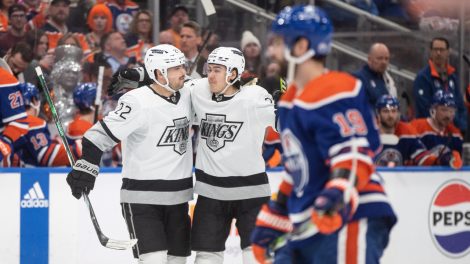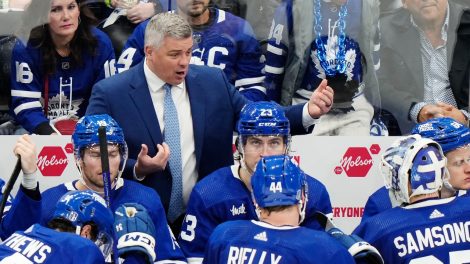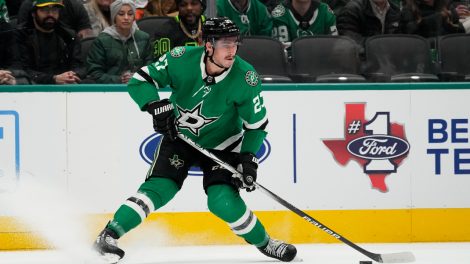Much of the new wave of NHL enhanced stats is based on shot metrics, most famously Corsi. The basic premise is that while shooting and save percentage can fluctuate, good teams consistently out-shoot their opposition.
This is true, but it can lead to a shortsighted view of the game, one which understates how much other factors play in to wins and losses.
This is easily demonstrated if we look at what it actually means be a 51 per cent Corsi team.
As it turns out, the answer is not much.
If we imagine two teams that are perfectly league-average in every way — special teams, shooting talent, goaltending, percentage of shot attempts blocked — except that one is a 50 per cent Corsi team and the other is a 51 per cent Corsi team the difference between the two clubs would be exactly six goals over the course of a season.
There are lots of ways for those six goals to disappear, as we see when we look around the league. For instance, talking about the 2013-14 Vancouver Canucks, current Columbus Blue Jackets head coach John Tortorella groused to a Tampa Bay radio station that the team was “10th in puck possession and finished 25th,” leaving him skeptical as to the value of enhanced stats.
It’s a good example for our purposes because that year the Canucks had a 51.3 per cent Corsi. They weren’t quite as good at getting shot attempts on net as their opponents, resulting in a 51.1 per cent shot differential, almost a perfect match for our hypothetical 51 per cent Corsi team.
Vancouver should have been plus-six on the year, all else being equal. Unfortunately for the Canucks, all else wasn’t equal.
The team’s shooting percentage was a half-point below the league average, which cost the club nine goals, erasing the advantage. Special teams weren’t average either, as they finished minus-three. Then, with either net empty, the Canucks were awful: getting outscored 8-2 when the opposing goalie was pulled, and 8-0 when their own goalie was out. Eight times the opposition was able to tie the game late; Vancouver never managed that once.
That makes it important not to overstate the value of being a good Corsi team.
A strong goalie can go a long way. If we imagine, for example, Montreal as being league average in every way (including Corsi) but able to consistently get goaltending 10 save percentage points better than average, they’re already 14 goals above break-even. If they go head-to-head with a 52 per cent Corsi team with average goaltending they’re going to win more often than not.
A high shooting percentage can do wonders, too. Anaheim was just a whisper above average in shot differential from 2012-15, but led the NHL with a 9.02 shooting percentage at even-strength. That, in combination with slightly superior goaltending meant that over an average 82-game season the Ducks were 31 goals above average. That’s the equivalent of an otherwise average team that has a 55 per cent Corsi.
Even without considering special teams, it’s easy to understand why a slightly good or slightly bad Corsi team might have a dramatically different goal differential than is suggested by their puck possession.
So why do we bother with Corsi when its effects can be swamped by other factors? Because it’s predictive.
If we compare team Corsi numbers from the last season and a half to the preceding 130 games (48 games in 2012-13, 82 in 2013-14) we end up with a chart that looks like this:
(Canadian teams and outliers highlighted)
There’s some movement, with New Jersey in particular standing out as a team that changed its Corsi number significantly. However, most of the league falls into a fairly straight diagonal line, with the bad teams in the bottom left and the good ones in the upper right.
This is in stark contrast to other metrics.
Shooting percentage fluctuates wildly. We mentioned Anaheim as the NHL’s best shooting percentage team over the last three seasons; this year they are literally the worst. Goaltending isn’t much better, because outside of a few names (Carey Price, Henrik Lundqvist, a handful of others) neither we nor general managers are good at predicting it, as was demonstrated eloquently by writer Rob Vollman:
Because those other metrics bounce around so much, at the team level Corsi is actually a slightly better predictor of goal differential than goal differential itself is.
A lot of what shows up in a team’s annual goal differential is noise; Corsi and other shot metrics are the steady signal in the background. For a general manager looking at building a team, shot differential is an incredibly valuable tool.
However, it is important not to overstate the effects of shot metrics like Corsi in the short term.
The five best teams and the five worst teams in the league are generally so good/so bad that their destiny will be dictated by the shot metrics, but for the league’s other 20 teams the quality of the goaltender, special teams and even a hot shooting percentage run can make all the difference.











